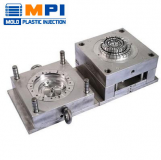Plastic injection molding is a widely used manufacturing process that involves injecting molten plastic into a mold to create various products. One of the most important factors in this process is the plastic injection pressure. It plays a crucial role in determining the quality, consistency, and efficiency of the final product.
We will explain how it affects the manufacturing process and what factors can influence it. Finally, we will discuss how adjusting and optimizing plastic injection pressure can help you achieve better results in your injection molding projects. If you are involved in the plastic injection molding industry or interested in learning more about it, keep reading!
Introduction to Plastic Injection Pressure:
Plastic injection pressure is a critical component of the injection molding process. Proper control and management of plastic injection mold pressure ensures consistency in production and high-quality molded parts. Injection pressure plays an important role in determining part shrinkage and warpage, so it must be carefully controlled.
The type of material used, mold design, and machine settings all contribute to plastic injection pressure. To achieve optimal results, regular monitoring and adjustments are necessary. The appropriate control of plastic injection pressure is essential for a successful injection molding process that yields efficient production and consistent quality outputs.
What is Plastic Injection Pressure and Why is it Important?
Plastic injection pressure is the force that pushes molten plastic into the mold cavity during the injection molding process. It is essential to maintain proper injection pressure to ensure consistent part quality and avoid defects such as voids, sink marks, or warping. Injection pressure is influenced by various factors such as material viscosity, mold design, and machine settings.
Monitoring and adjusting injection pressure can help optimize cycle time, reduce scrap rates, and improve overall productivity. Plastic manufacturers must understand the importance of plastic injection pressure to ensure successful injection molding operations. Without proper attention to injection pressure, defects may arise in production and cause damage to the final product. Therefore, it is crucial for manufacturers to maintain an optimal level of plastic injection pressure throughout the entire manufacturing process.
Understanding the Effects of Plastic Injection Pressure:
The pressure applied during the plastic injection process affects the quality and consistency of the final product. Higher injection pressure can help to fill complex molds, reduce defects and increase product density. Lower injection pressure can result in lighter-weight parts and reduced material waste. It is essential to control injection pressure for efficiency and cost-effectiveness during production.
Maintaining a proper balance of plastic injection pressure is crucial to ensure that the desired product quality is achieved. Furthermore, it helps to reduce production downtime caused by poor-quality products or machine malfunctioning. Plastic injection molding companies have specialized equipment that allows them to monitor and adjust the plastic injection pressure for each product they manufacture. This technology also enables manufacturers to optimize their processes, resulting in cost savings over time.
Factors Affecting Plastic Injection Pressure:
Several factors can impact plastic injection pressure in the injection molding process. Material type and viscosity, as well as the size and complexity of the part being molded, can affect the required injection pressure. Maintaining consistent temperature control is also crucial to ensure optimal plastic injection pressure. Machine performance and hydraulic systems play a critical role in achieving the correct injection pressure.
Proper maintenance and calibration of machinery are essential for maintaining optimal plastic injection pressure. The success of the final product depends heavily on the appropriate level of plastic injection pressure during the molding process. Manufacturers must pay close attention to these factors to ensure that their products meet quality standards consistently.
Adjusting and Optimizing Plastic Injection Pressure:
Plastic injection pressure plays a crucial role in determining the quality and consistency of the final product in injection molding. Several factors can affect injection pressure, including material type, mold design, and machine settings. Adjusting the injection pressure can help to prevent defects such as sink marks and warpage in the final product. Optimizing injection pressure can also improve cycle times and reduce production costs.
To achieve optimal results, it’s essential to work with experienced professionals who can properly adjust and optimize injection pressure for each project. This ensures that the final product meets all quality standards while keeping production costs under control. By taking these steps, manufacturers can produce high-quality products efficiently and effectively.
Conclusion:
In conclusion, plastic injection pressure plays a crucial role in ensuring the quality and consistency of injection molded products. It is essential to understand the effects of pressure on the molding process, as well as the factors that can impact it. By adjusting and optimizing plastic injection pressures, manufacturers can achieve better product quality, reduce waste, and increase efficiency. If you want to learn more about plastic injection pressures and how it affects injection molding, reach out to our experts for a consultation today.
 Plastic Injection Mold Material Guide – Advantages & Applications Of 20 Common Injection Molding Materials
Plastic Injection Mold Material Guide – Advantages & Applications Of 20 Common Injection Molding Materials  10 Plastic Injection Processes – Advantages, Disadvantages, And Applications Of Plastic Injection
10 Plastic Injection Processes – Advantages, Disadvantages, And Applications Of Plastic Injection  The three key factors affecting mold cost have nothing to do with materials!
The three key factors affecting mold cost have nothing to do with materials!  Custom Plastic Mold Injection Molds: Revolutionizing Manufacturing Processes
Custom Plastic Mold Injection Molds: Revolutionizing Manufacturing Processes